编写连接ESP8266 WiFi模块(ESP8266-01S芯片)WiFi的Android客户端APP控制单片机外围LED灯亮灭
一、编写连接ESP8266 WiFi模块(ESP8266-01S芯片)WiFi的Android客户端APP控制单片机外围LED灯亮灭的原理
二、编写连接ESP8266 WiFi模块(ESP8266-01S芯片)WiFi的Android客户端APP控制单片机外围LED灯亮灭的步骤
1、借助USB-TTL串口使用PC端串口调试助手软件对ESP8266 WiFi模块(ESP8266-01S芯片)发送激活ESP8266 WiFi模块(ESP8266-01S芯片)WiFi功能AT指令调试
(1)、USB-TTL串口与ESP8266 WiFi模块(ESP8266-01S芯片)接线图

 (2)、使用PC端串口调试助手软件(如:安信可串口调试助手软件)对ESP8266 WiFi模块(ESP8266-01S芯片)发送激活ESP8266 WiFi模块(ESP8266-01S芯片)WiFi功能AT指令调试
(2)、使用PC端串口调试助手软件(如:安信可串口调试助手软件)对ESP8266 WiFi模块(ESP8266-01S芯片)发送激活ESP8266 WiFi模块(ESP8266-01S芯片)WiFi功能AT指令调试
<1>、在安信可官网下载安信可串口调试助手软件

<2>、双击打开安信可串口调试助手软件,弹出以下界面。
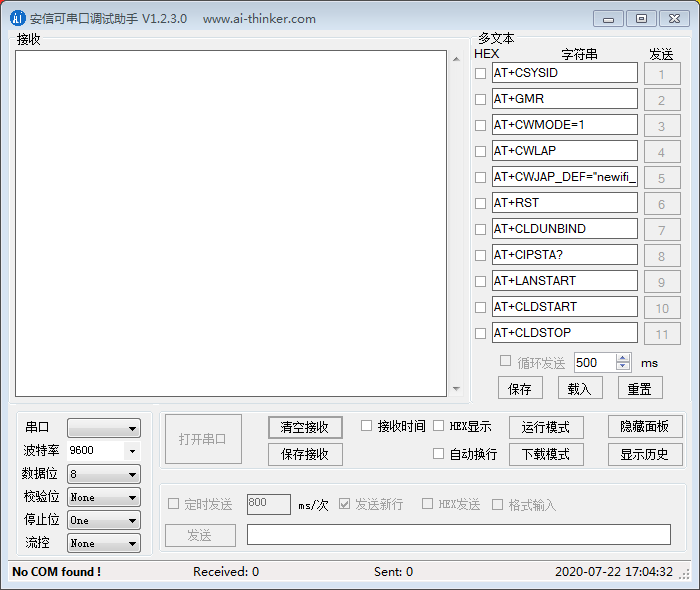
<3>、USB转TTL串口与ESP8266 WiFi模块(ESP8266-01S芯片)相互连线后再与电脑连接。
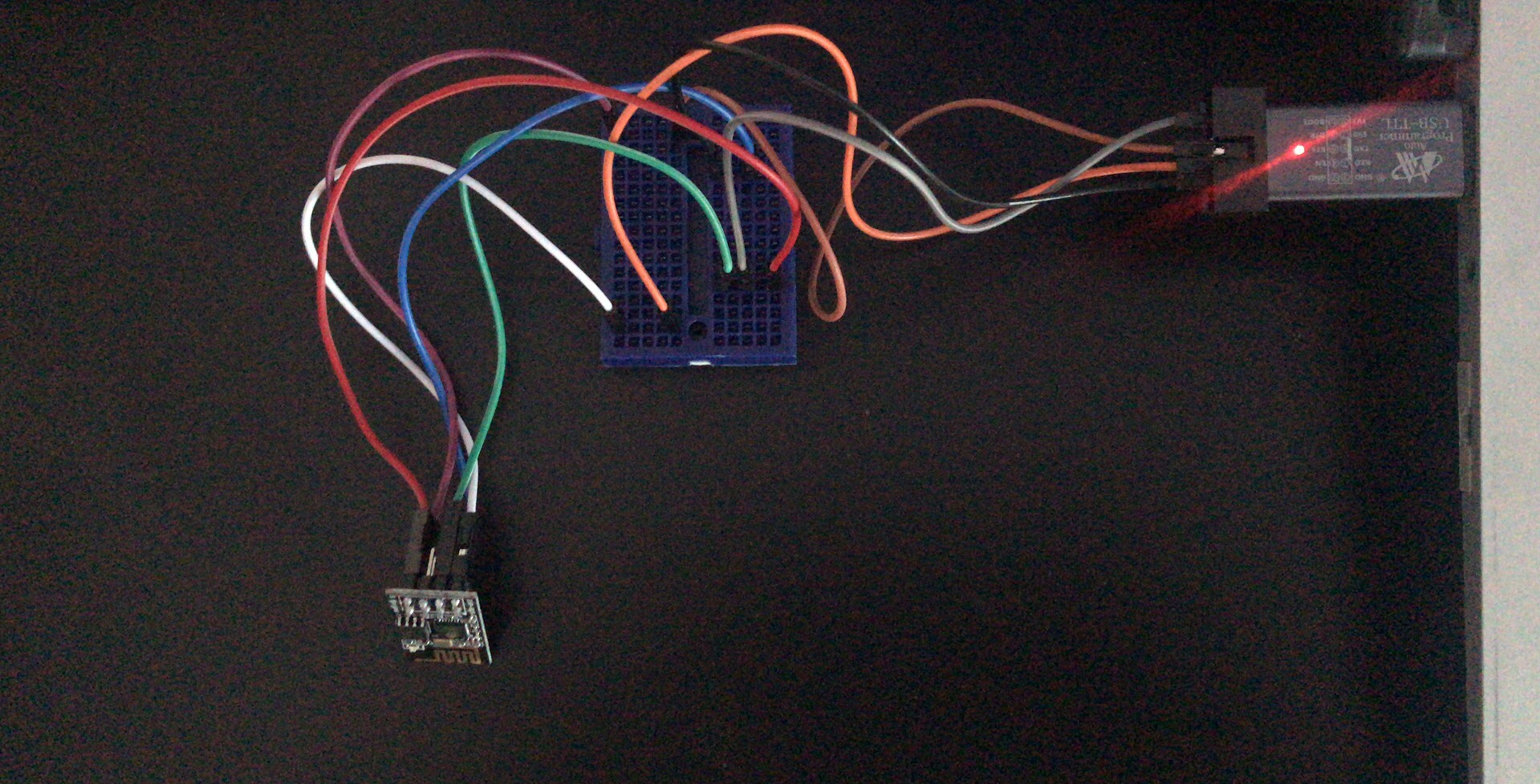
<4>、USB转TTL串口与ESP8266 WiFi模块(ESP8266-01S芯片)相互连线再与电脑连接后,右键点击电脑上的计算机,在弹出列表中选中属性,此时弹出一个关于电脑控制面板的信息界面,点击左上边设备管理器,弹出设备管理器界面,找到端口项点开,出现新增一个通信串口:COM3。

<5>、回到安信可串口调试助手软件界面端口处选COM3端口,在波特率处将4800改为115200,如以下界面。
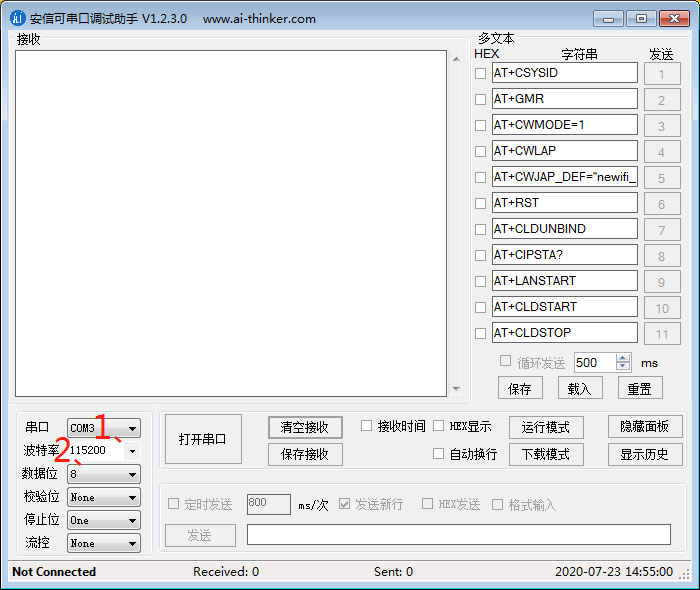
<6>、在安信可串口调试助手软件界面点击“打开串口”后,弹出以下界面。

<7>、由于STC系列单片机与ESP8266 WiFi模块(ESP8266-01S芯片)是在波特率为9600下进行通信,而ESP8266 WiFi模块(ESP8266-01S芯片)默认波特率是115200,因此需要使用安信可串口调试助手软件来修改ESP8266 WiFi模块(ESP8266-01S芯片)波特率为9600,操作如下所示。
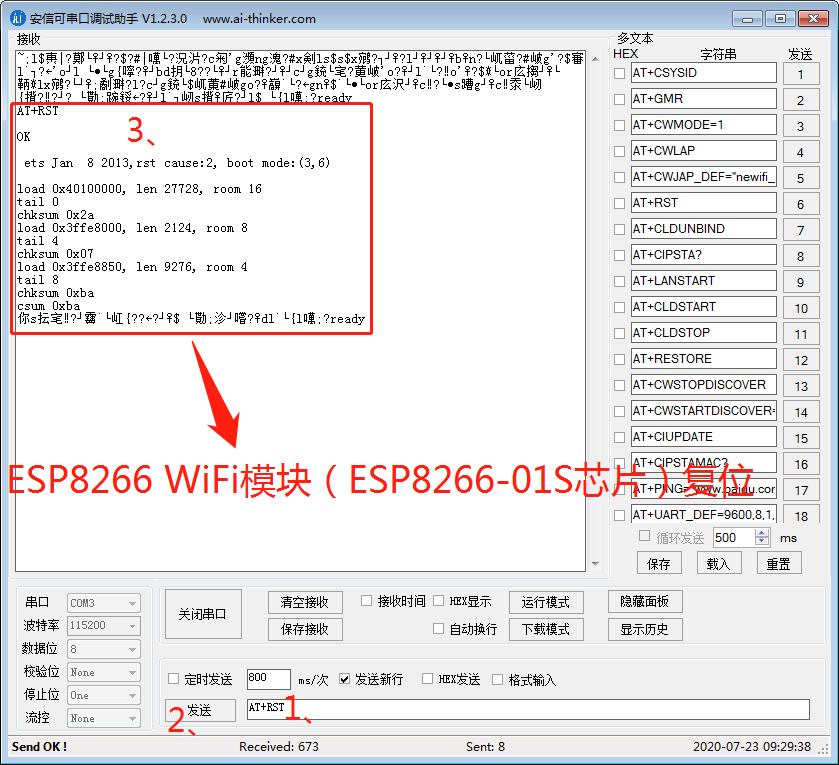
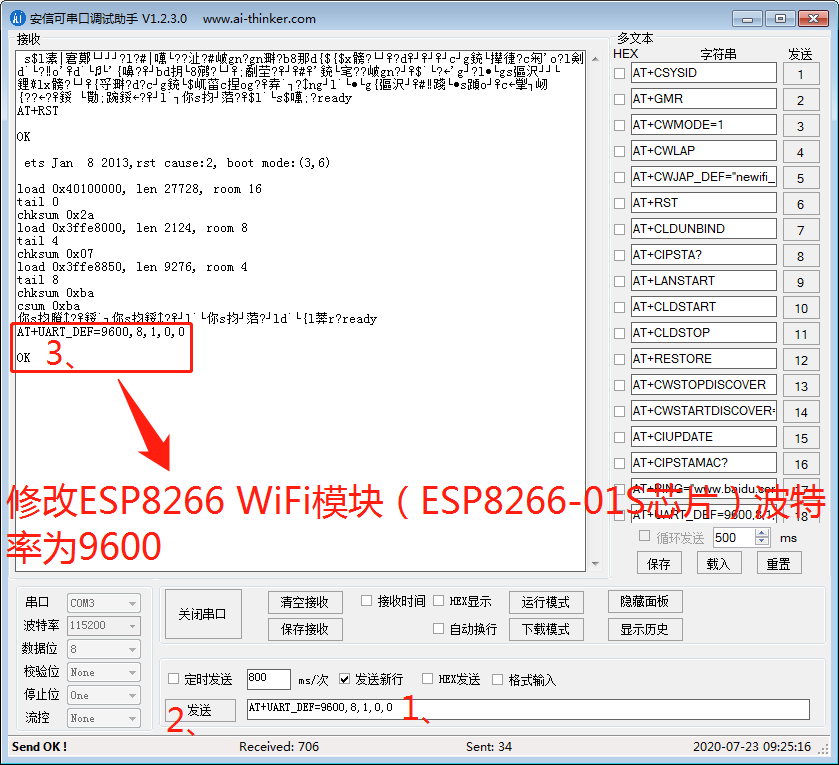
<8>、使用安信可串口调试助手软件来修改ESP8266 WiFi模块(ESP8266-01S芯片)波特率为9600后,在安信可串口调试助手软件界面点击“关闭串口”,回到安信可串口调试助手软件界面端口处选COM3端口不变,在波特率处将115200改为9600,如以下界面。
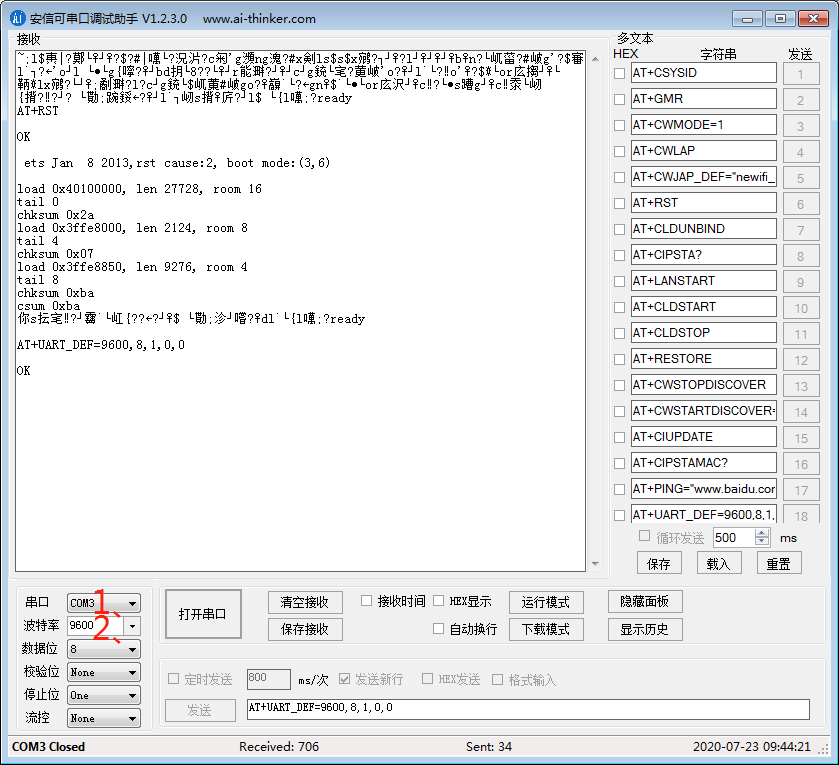
<9>、在安信可串口调试助手软件界面点击“打开串口”,发送项右侧空白栏输入“AT+RST”验证安信可串口调试助手软件在修改ESP8266 WiFi模块(ESP8266-01S芯片)波特率为9600后,是否能与ESP8266 WiFi模块(ESP8266-01S芯片)正常通信,否则安信可串口调试助手软件界面无信息返回,操作如下所示。

<10>、使用安信可串口调试助手软件对ESP8266 WiFi模块(ESP8266-01S芯片)发送激活ESP8266 WiFi模块(ESP8266-01S芯片)WiFi功能AT指令调试,操作如下所示。

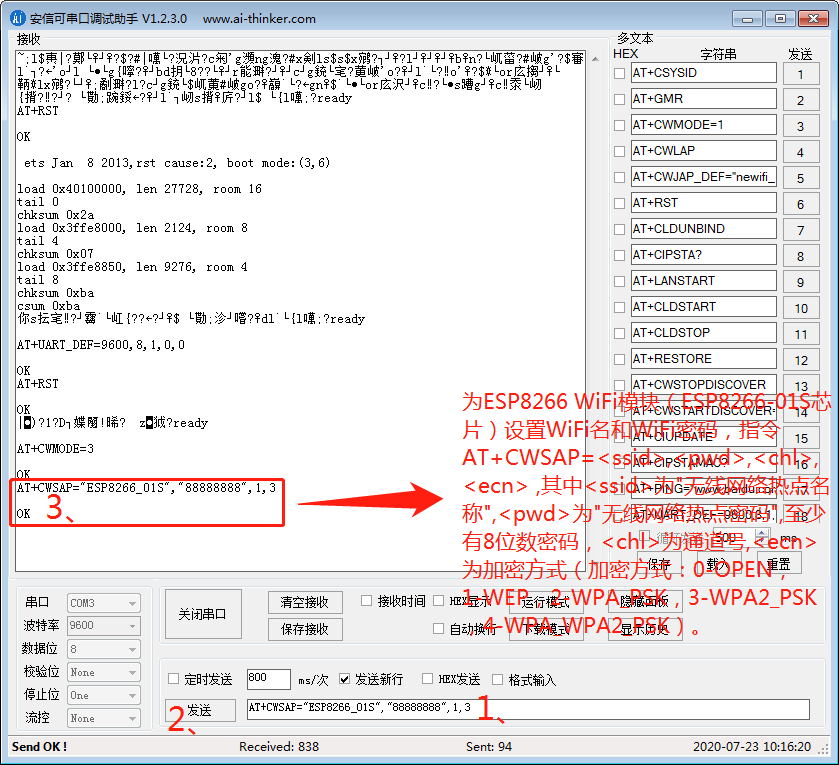
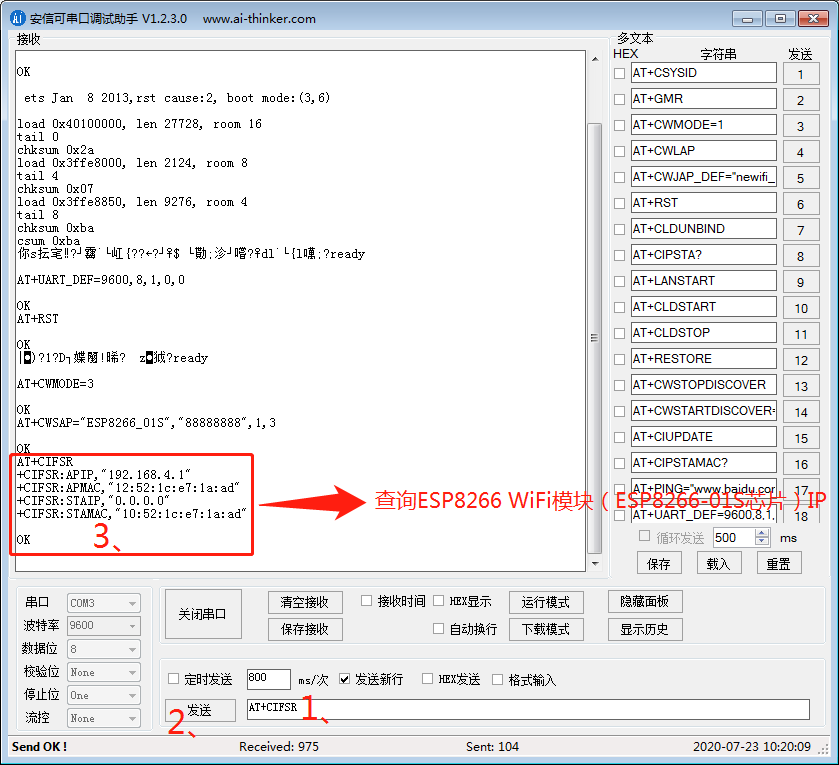


2、用手机端安卓编程软件AIDE编写连接ESP8266 WiFi模块(ESP8266-01S芯片)WiFi的Android客户端APP安卓程序(也可用Eclipse集成安卓开发环境或Android Studio软件编写连接ESP8266 WiFi模块(ESP8266-01S芯片)WiFi的Android客户端APP安卓程序,使用手机端安卓编程软件AIDE编写连接ESP8266 WiFi模块(ESP8266-01S芯片)WiFi的Android客户端APP安卓程序可以减少错误发生,还可以直接生成连接ESP8266 WiFi模块(ESP8266-01S芯片)WiFi的Android客户端APP,十分方便。)
(1)、编写连接ESP8266 WiFi模块(ESP8266-01S芯片)WiFi的Android客户端APP安卓主程序
package com.example.esp8266androidclient; import java.io.IOException; import java.io.PrintStream; import java.net.Socket; import android.os.Bundle; import android.support.v7.app.ActionBarActivity; import android.view.View; import android.widget.Button; import android.widget.EditText; import android.widget.Toast; public class ESP8266AndroidClientMainActivity extends ActionBarActivity implements View.OnClickListener { private EditText IP;//IP private EditText PORT;//端口号 private String stringip;//字符串类型IP private int stringport;//字符类型端口号 private Button connect;//连接 private Socket socket;//套接字 private PrintStream out;//打印输出流 private ConnectThread connectthread;//连接线程 private Button open;//按钮LED灯开 private Button close;//按钮LED灯关 @Override protected void onCreate(Bundle savedInstanceState) { super.onCreate(savedInstanceState); setContentView(R.layout.activity_esp8266_android_client_main); connect=(Button)findViewById(R.id.button1); open=(Button)findViewById(R.id.button2); close=(Button)findViewById(R.id.button3); IP=(EditText)findViewById(R.id.editextip); PORT=(EditText)findViewById(R.id.editextport); connect.setOnClickListener(this); open.setOnClickListener(this); close.setOnClickListener(this); } @Override public void onClick(View v) { switch(v.getId()) { case R.id.button1: if( socket == null || ! socket.isConnected()) { stringip = IP.getText().toString(); stringport = Integer.valueOf(PORT.getText().toString()); connectthread = new ConnectThread(stringip, stringport); connectthread.start(); } if(socket != null && socket.isConnected()) { try { socket.close(); socket=null; // 清空mSocket connect.setText("连接"); Toast.makeText(ESP8266AndroidClientMainActivity.this,"连接已关闭", Toast.LENGTH_LONG).show(); } catch (IOException e) { e.printStackTrace(); } } break; case R.id.button2: if(out!=null) { out.print("0"); out.flush(); } break; case R.id.button3: if (out!=null) { out.print("1"); out.flush(); } break; } } private class ConnectThread extends Thread { private String ip; private int port; public ConnectThread(String ip,int port){ this.ip=ip; this.port=port; } @Override public void run() { try { socket=new Socket(ip,port); out = new PrintStream(socket.getOutputStream()); runOnUiThread(new Runnable() { @Override public void run() { connect.setText("断开"); Toast.makeText(ESP8266AndroidClientMainActivity.this,"连接成功",Toast.LENGTH_LONG).show(); } }); } catch (IOException e) { e.printStackTrace(); runOnUiThread(new Runnable() { @Override public void run() { connect.setText("断开"); Toast.makeText(ESP8266AndroidClientMainActivity.this,"连接失败",Toast.LENGTH_LONG).show(); } }); } } } }
(2)、编写连接ESP8266 WiFi模块(ESP8266-01S芯片)WiFi的Android客户端APP安卓界面布局程序
<RelativeLayout xmlns:android="http://schemas.android.com/apk/res/android" xmlns:tools="http://schemas.android.com/tools" android:layout_width="match_parent" android:layout_height="match_parent" android:orientation="vertical" android:paddingBottom="@dimen/activity_vertical_margin" android:paddingLeft="@dimen/activity_horizontal_margin" android:paddingRight="@dimen/activity_horizontal_margin" android:paddingTop="@dimen/activity_vertical_margin" tools:context="com.example.esp8266androidclient.ESP8266AndroidClientMainActivity" > <LinearLayout android:id="@+id/linearLayout1" android:layout_width="match_parent" android:layout_height="wrap_content" android:layout_alignParentLeft="true" android:layout_alignParentTop="true" > <TextView android:id="@+id/textView1" android:layout_width="wrap_content" android:layout_height="wrap_content" android:text="服务器地址:" android:textSize="20dp" /> <EditText android:id="@+id/editextip" android:layout_width="wrap_content" android:layout_height="wrap_content" android:layout_weight="1" android:ems="10" android:hint="ESP8266 WiFi模块WiFi地址号" android:inputType="textPersonName" /> </LinearLayout> <LinearLayout android:id="@+id/linearLayout2" android:layout_width="match_parent" android:layout_height="wrap_content" android:layout_alignLeft="@+id/linearLayout1" android:layout_below="@+id/linearLayout1" > <TextView android:id="@+id/textView2" android:layout_width="wrap_content" android:layout_height="wrap_content" android:text="服务器端口:" android:textSize="20dp" /> <EditText android:id="@+id/editextport" android:layout_width="wrap_content" android:layout_height="wrap_content" android:layout_weight="1" android:ems="10" android:hint="ESP8266 WiFi模块WiFi端口号" android:inputType="textPersonName" /> </LinearLayout> <Button android:id="@+id/button1" android:layout_width="match_parent" android:layout_height="wrap_content" android:layout_alignLeft="@+id/linearLayout2" android:layout_below="@+id/linearLayout2" android:layout_marginTop="30dp" android:text="连接"/> <Button android:id="@+id/button2" android:layout_width="match_parent" android:layout_height="wrap_content" android:layout_alignLeft="@+id/button1" android:layout_below="@+id/button1" android:layout_marginTop="30dp" android:text="打开" /> <Button android:id="@+id/button3" android:layout_width="match_parent" android:layout_height="wrap_content" android:layout_alignLeft="@+id/button2" android:layout_below="@+id/button2" android:layout_marginTop="30dp" android:text="关闭" /> </RelativeLayout>
(3)、编写连接ESP8266 WiFi模块(ESP8266-01S芯片)WiFi的Android客户端APP安卓属性权限程序
<?xml version="1.0" encoding="utf-8"?> <manifest xmlns:android="http://schemas.android.com/apk/res/android" package="com.example.esp8266androidclient" android:versionCode="1" android:versionName="1.0" > <uses-sdk android:minSdkVersion="8" android:targetSdkVersion="21" /> <uses-permission android:name="android.permission.INTERNET"></uses-permission> <uses-permission android:name="android.permission.WRITE_EXTERNAL_STORAGE"></uses-permission> <uses-permission android:name="android.permission.READ_EXTERNAL_STORAGE"></uses-permission> <application android:allowBackup="true" android:icon="@drawable/ic_launcher" android:label="@string/app_name" android:theme="@style/AppTheme" > <activity android:name=".ESP8266AndroidClientMainActivity" android:label="@string/app_name" > <intent-filter> <action android:name="android.intent.action.MAIN" /> <category android:name="android.intent.category.LAUNCHER" /> </intent-filter> </activity> </application> </manifest>
(4)、编写连接ESP8266 WiFi模块(ESP8266-01S芯片)WiFi的Android客户端APP字符串资源程序
<?xml version="1.0" encoding="utf-8"?> <resources> <string name="app_name">ESP8266AndroidClient</string> <string name="action_settings">Settings</string> </resources>
(5)、生成连接ESP8266 WiFi模块(ESP8266-01S芯片)WiFi的Android客户端APP
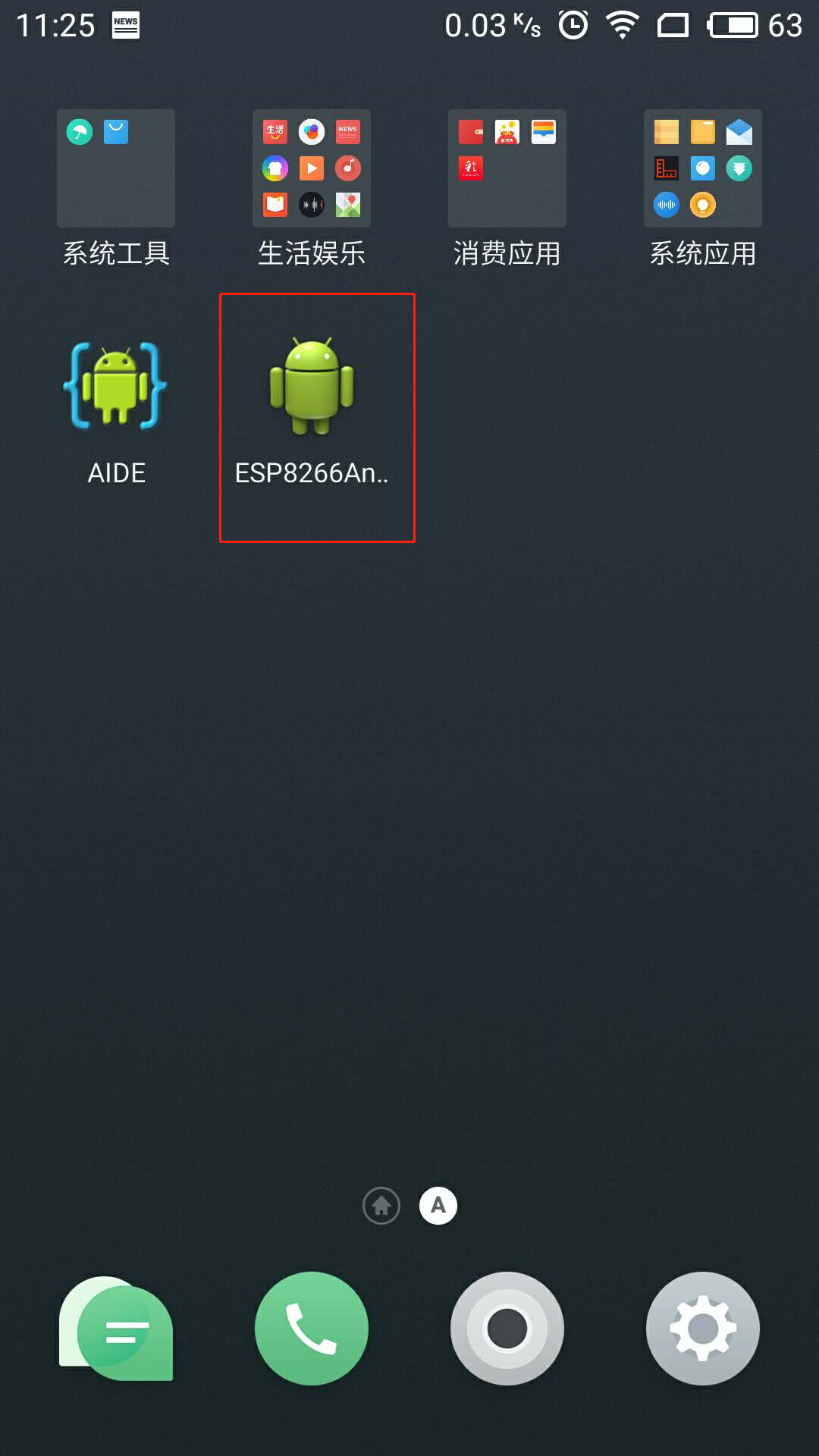
3、激活ESP8266 WiFi模块(ESP8266-01S芯片)WiFi功能后,将编写好连接ESP8266 WiFi模块(ESP8266-01S芯片)WiFi的Android客户端APP对ESP8266 WiFi模块(ESP8266-01S芯片)进行连接调试。
<1>、点开手机端设置,找到无线网络并点开,弹出以下界面。

<2>、点开被激活的ESP8266 WiFi模块WiFi,输入密码,点击连接,操作如下所示。
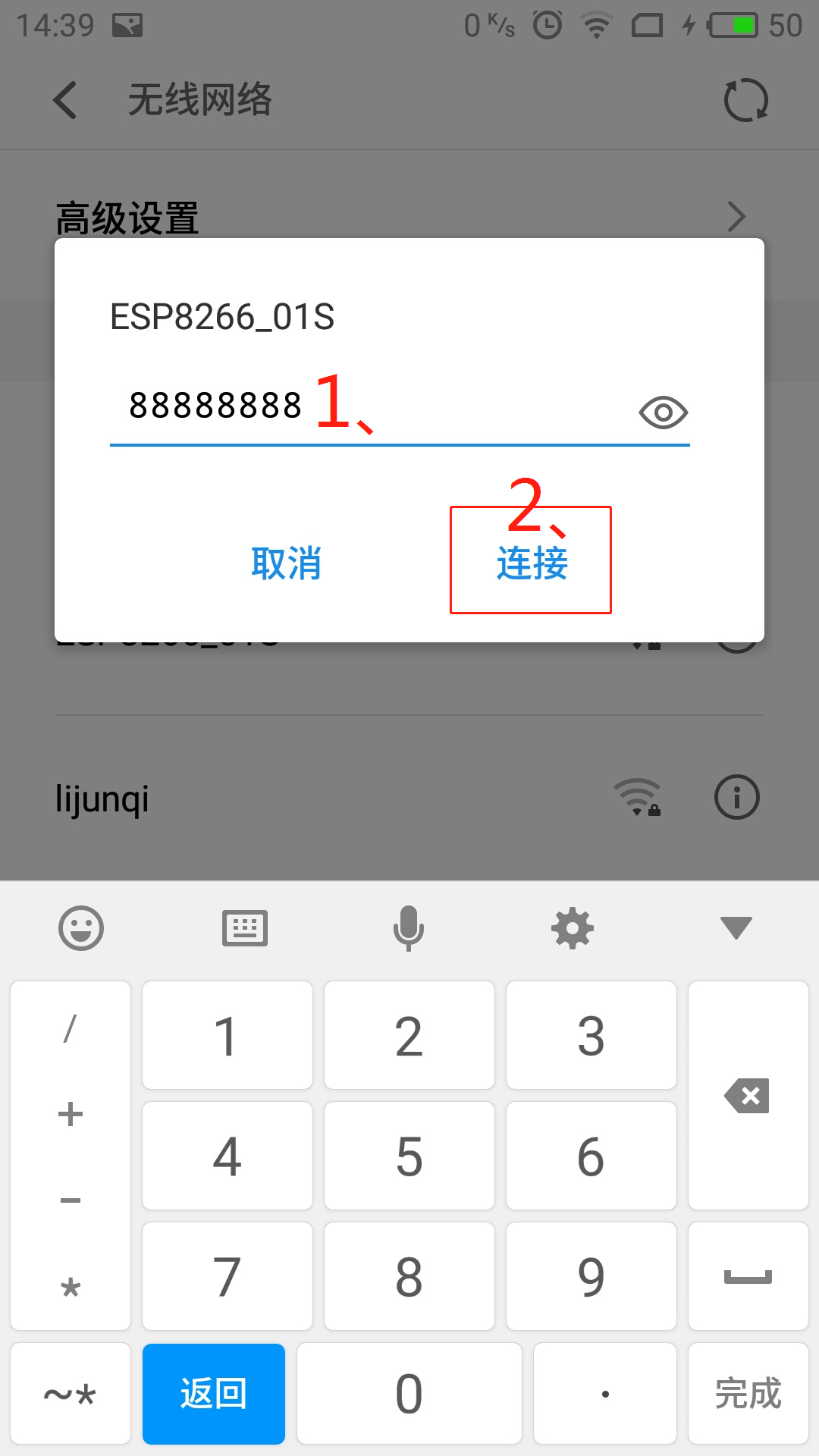
<3>、点击连接后,若连接成功,弹出以下界面。

<4>、查看连接ESP8266 WiFi模块(ESP8266-01S芯片)WiF成功后WiFi相关信息,如以下界面。
<5>、点开所生成连接ESP8266 WiFi模块(ESP8266-01S芯片)WiFi的Android客户端APP“ESP8266AndroidClient”,弹出以下界面。
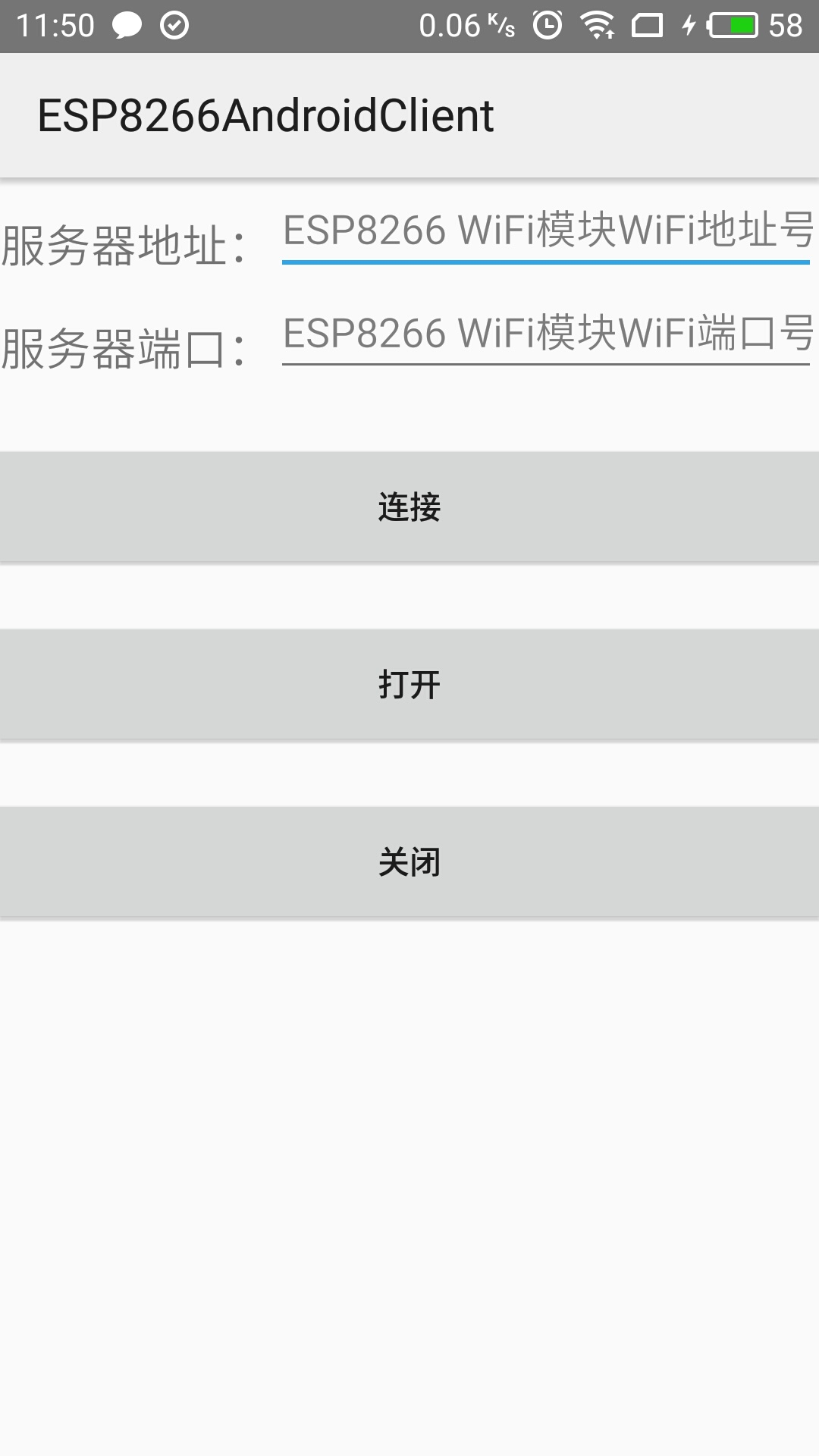
<6>、在连接ESP8266 WiFi模块(ESP8266-01S芯片)WiFi的Android客户端APP“ESP8266AndroidClient”界面,输入ESP8266 WiFi模块(ESP8266-01S芯片)WiFi的地址号(即IP号)以及ESP8266 WiFi模块(ESP8266-01S芯片)WiFi的端口号,再点击连接,操作如下所示。

<7>、在连接ESP8266 WiFi模块(ESP8266-01S芯片)WiFi的Android客户端APP“ESP8266AndroidClient”界面,点击连接后,若连接成功,弹出以下界面。
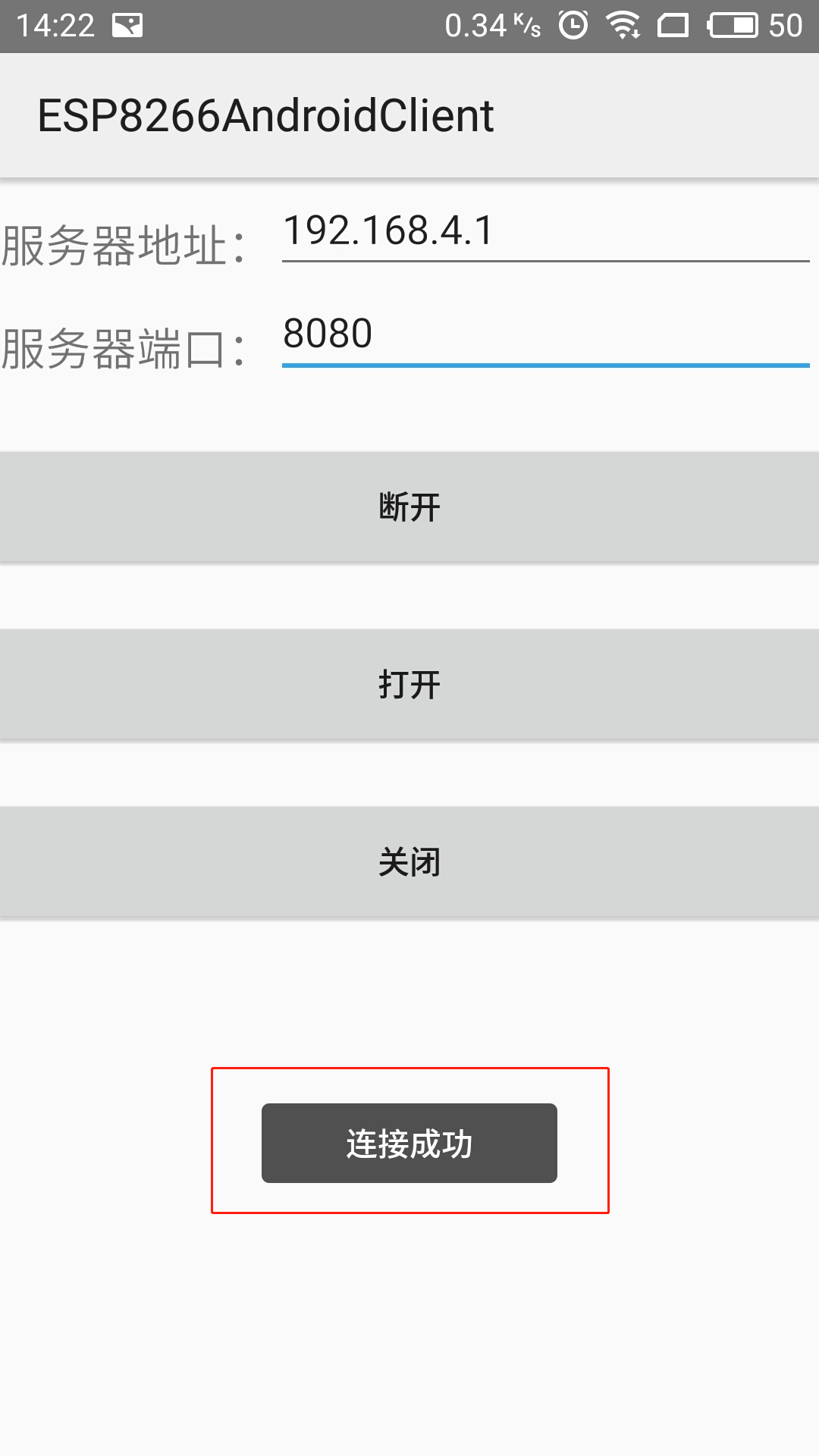
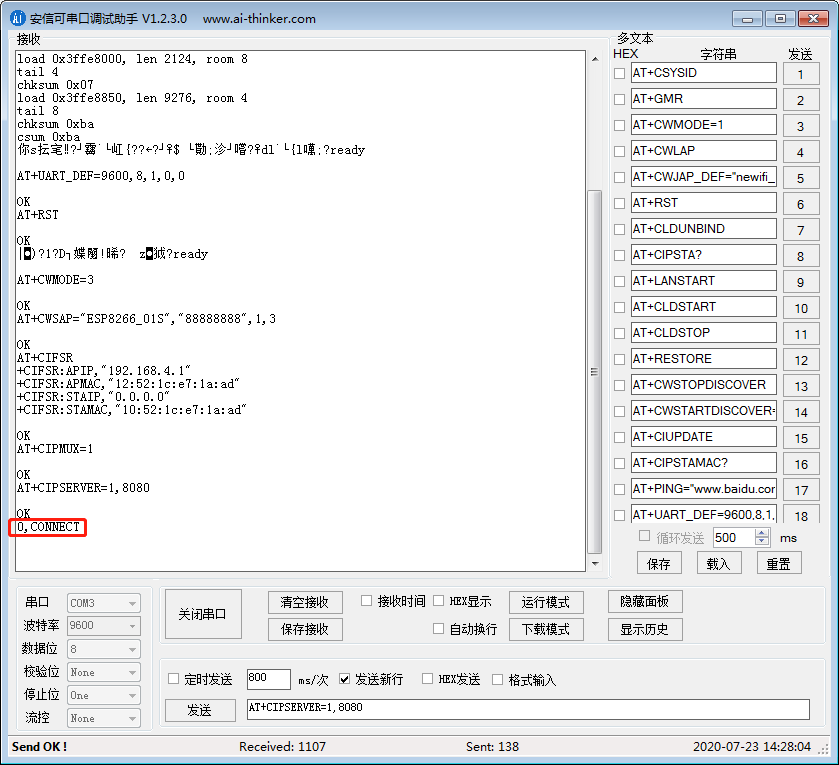
4、结合使用PC端串口调试助手软件对ESP8266 WiFi模块(ESP8266-01S芯片)发送激活ESP8266 WiFi模块(ESP8266-01S芯片)WiFi功能AT指令调试情况编写单片机C语言程序
#include <reg52.h> #include <string.h> #include <stdio.h> sbit led=P2^0;//位定义P2^0为LED灯端口 //sbit send=P3^2;//位定义P3^2为发送端口 char Recive_table[20]="";//接收数据数组变量 char reciveflag = 0;//接收标志位变量 void UART_Init(void)//单片机串口初始化函数 { TMOD=0x20;//0010 0000定时器工作方式为方式2,8位自动重装。 TH1=0xfd;//初始化计数器高8位:1111 1101 TL1=0xfd;//初始化计数器低8位 TR1=1;//启动定时器1 SM0=0;//设定串口工作方式为方式1(10位异步通信) SM1=1;//设定串口工作方式 REN=1;//打开串口中断接收允许 EA=1;//打开全局中断 ES=1;//打开串口中断允许位 } void UART_Interrupt() interrupt 4//单片机串口中断函数 { // static char i=0; // if(RI==1)//判断串口接收中断标志位是否为1,若串口接收中断标志位为1,表示单片机接收数据缓存寄存器接收数据结束。 // { // ES = 0;//关闭串口中断允许位,阻止进入串口中断服务程序。为什么要设置ES=0?由于单片机接收数据缓存寄存器接收ESP8266 WiFi模块从某设备获取的数据结束后,RI(即串口接收中断标志位)=1,申请串口中断,若ES不设置为0,在RI(即串口接收中断标志位)=1时,申请串口中断进入串口中断服务程序,形成固定循环,导致无法运行其他程序。 // RI=0;//表示单片机接收数据缓存寄存器可重新接收数据,不可申请串口中断。 // Recive_table[i]=SBUF;//单片机接收缓存器接收ESP8266 WiFi模块从某设备获取的数据赋给数组变量Recive_table[] // i++; // if((Recive_table[i-1] == '\n'))//判断单片机接收缓存器接收ESP8266 WiFi模块从某设备获取的数据是否有换行。 // { // Recive_table[i]='\0';//单片机接收缓存器接收ESP8266 WiFi模块从某设备获取的数据在i这个位置结束。 // i=0; // reciveflag = 1;//接收标志位变量置1 // } // ES = 1;//打开串口中断允许位,允许进入串口中断服务程序。 // } // else // TI = 0;//TI(即串口发送中断标志位)=0,表示单片机发送数据缓存寄存器可重新给PC端串口调试助手发送数据,不可申请串口中断。 } void Delay(int t)//延时函数 { int i,j; for(i=t;i>0;i--) for(j=110;j>0;j--); } void LED(void)//LED灯指示函数,用来提示单片机是在给ESP8266 WiFi模块发送激活WiFi功能的AT指令。 { P2 = 0; Delay(100); P2 = 0xff; Delay(100); } void WiFi_Init(void)//ESP8266 WiFi模块发射WiFi初始化函数,相当于在PC端串口调试助手软件界面输入激活ESP8266 WiFi模块发射WiFi的AT指令这一过程。 { ES = 0;//关闭串口中断允许位,阻止进入串口中断服务程序。为什么要设置ES=0?由于单片机发送数据缓存寄存器给PC端串口调试助手发送数据结束后,TI(即串口发送中断标志位)=1,若ES不设置为0,在TI(即串口发送中断标志位)=1时,申请串口中断进入串口中断服务程序执行串口中断服务程序。 TI = 1;//TI(即串口发送中断标志位)=0,表示单片机发送数据缓存寄存器可给PC端串口调试助手发送数据结束,申请串口中断。 printf("AT+RST\r\n");//复位ESP8266 WiFi模块(ESP8266-01S芯片) LED(); Delay(1000) ; printf("AT+CWMODE=3\r\n");//为ESP8266 WiFi模块(ESP8266-01S芯片)设置工作模式,指令AT+CWMODE=<mode>,其中<mode>:1:Station模式(充当客户端,用来连接其他无线网络热点。),2:AP模式(充当服务器,用来发射无线网络热点,供其他设备连接。),3:Station模式+AP模式混合模式(即可充当服务器又可充当客户端,可用来发射无线网络热点,供其他设备连接,也可用来连接其他无线网络热点。) LED(); Delay(1000); printf("AT+CWSAP=\"ESP8266_01S\",\"88888888\",1,3\r\n");//为ESP8266 WiFi模块(ESP8266-01S芯片)设置WiFi名和WiFi密码,指令AT+CWSAP=<ssid>,<pwd>,<chl>,<ecn> ,其中<ssid>为"无线网络热点名称",<pwd>为"无线网络热点密码",至少有8位数密码,<chl>为通道号,<ecn>为加密方式(加密方式:0-OPEN,1-WEP,2-WPA_PSK,3-WPA2_PSK,4-WPA_WPA2_PSK)。 LED(); Delay(1000) ; printf("AT+CIFSR\r\n"); //查询ESP8266 WiFi模块(ESP8266-01S芯片)IP LED(); Delay(1000) ; // printf("AT+CWLIF\r\n");//查看接入ESP8266 WiFi模块(ESP8266-01S芯片)WiFi热点的某设备IP // LED(); // Delay(1000) ; printf("AT+CIPMUX=1\r\n");//为ESP8266 WiFi模块(ESP8266-01S芯片)开启多连接模式,指令AT+CIPMUX=1,0:单路连接,1:多路连接。 LED(); Delay(1000) ; printf("AT+CIPSERVER=1,8080\r\n");//为ESP8266 WiFi模块(ESP8266-01S芯片)开启服务器模式,指令AT+CIPSERVER=1(0:关闭服务器模式,1:开启服务器模式),8080(端口号,缺省值为333)。注意:当AT+CIPMUX=1时才能开启服务器,关闭服务器模式需要重启。开启服务器后自动建立服务器监听,当有客户端接入会自动按顺序占用一个连接。 LED(); Delay(1000) ; // printf("AT+UART_DEF=9600,8,1,0,0\r\n");//修改ESP8266 WiFi模块波特率为9600 // LED(); // Delay(1000); // printf("AT+CIPSTATUS\r\n"); //查询ESP8266 WiFi模块当前连接情况,指令AT+CIPSTATUS;响应:+ CIPSTATUS:<id>,<type>,<addr>,<port>,<tetype>,其中<id>为连接的id号,有0-4,<type>为字符串参数,类型TCP或UDP,<addr>为字符串参数,IP地址,<port>为端口号,<tetype>: 0-本模块作客户端连接,1-本模块作服务器连接。 // LED(); // Delay(1000) ; while(!TI);//判断串口发送中断标志位是否为1,若为1则单片机发送数据缓存寄存器给PC端串口调试助手发送数据结束。为什么在此编写while(!TI)?由于需要把单片机发送数据缓存寄存器保存的数据发送给PC端串口调试助手。 TI = 0;//TI(即串口发送中断标志位)=0,表示单片机发送数据缓存寄存器可重新给PC端串口调试助手发送数据,不可申请串口中断。 ES = 1;//打开串口中断允许位,允许进入串口中断服务程序。 } int main (void) { UART_Init();//串口初始化,波特率为9600 Delay(1000) ; WiFi_Init(); //wifi初始化 led=0; while(1) { Delay(10) ; if(reciveflag == 1)//判断接收标志位变量是否为1,接收标志位变量为1时,单片机通过串口通信接收ESP8266 WiFi模块从某终端获取的数据。 { ES=0;//关闭串口中断允许位,阻止进入串口中断服务程序。为什么要设置ES=0?由于单片机接收数据缓存寄存器接收ESP8266 WiFi模块从某终端获取的数据后,RI(即串口接收中断标志位)=1,申请串口中断,若ES不设置为0,在RI(即串口接收中断标志位)=1时,申请串口中断进入串口中断服务程序执行reciveflag=1,又得回来再次判断if(reciveflag==1),形成固定循环,导致无法运行其他程序。 if((Recive_table[0]=='+')&&(Recive_table[1]=='I')&&(Recive_table[2]=='P'))//判断单片机接收数据缓存寄存器接收ESP8266 WiFi模块从某终端获取的数据赋给数组变量Recive_table[]中第1、第2、第3、第4、第7的数据是否为:+IPD,x,x:y { if((Recive_table[3]=='D')&&(Recive_table[6]==',')) { if(Recive_table[9]=='0')//判断单片机接收数据缓存寄存器接收ESP8266 WiFi模块从某终端获取的数据赋给数组变量Recive_table[]中第10的数据是否为0 led = 0;//点亮LED灯 if(Recive_table[9]=='1')//判断单片机接收数据缓存寄存器接收ESP8266 WiFi模块从某终端获取的数据赋给数组变量Recive_table[]中第10的数据是否为1 led = 1;//熄灭LED灯 } } memset(Recive_table,'\0',20);//将数组Recive_table[]中的数据全部置空 reciveflag = 0;//接收标志位变量置0 ES=1;//打开串口中断允许位,允许进入串口中断服务程序。 } /*if(0 == send)//通过串口给手机发送字符串hello { Delay(400); if(0 == send) { ES = 0; TI = 1; printf("AT+CIPSEND=?\r\n"); LED(); Delay(1000) ; printf("AT+CIPSEND=0,10\r\n"); LED(); Delay(1000) ; printf("hello\r\n"); LED(); Delay(1000) ; LED(); Delay(1000) ; LED(); Delay(1000) ; while(!TI); TI = 0; ES = 1; } while(0 == send); } */ } }
5、给STC系列单片机烧写单片机C语言程序
(1)、给STC系列单片机烧写单片机C语言程序的接线图
(2)、STC系列单片机烧写单片机C语言程序成功表示图
6、将编写好连接ESP8266 WiFi模块(ESP8266-01S芯片)WiFi的Android客户端APP通过PC端串口调试助手软件借助USB-TTL串口对ESP8266 WiFi模块(ESP8266-01S芯片)及STC系列单片机进行通讯调试
(1)、USB-TTL串口、ESP8266 WiFi模块(ESP8266-01S芯片)及STC系列单片机通讯接线图


(2)、使用连接ESP8266 WiFi模块(ESP8266-01S芯片)WiFi的Android客户端APP通过PC端串口调试助手软件借助USB-TTL串口对ESP8266 WiFi模块(ESP8266-01S芯片)及STC系列单片机进行通讯调试
(3)、
7、
8、
9、
10、



